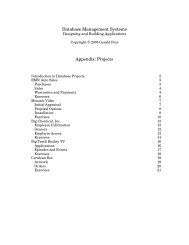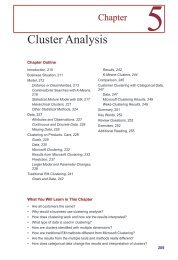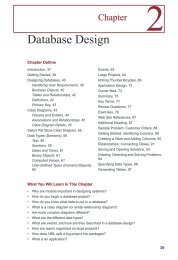Revision History - Jerry Post
Revision History - Jerry Post
Revision History - Jerry Post
You also want an ePaper? Increase the reach of your titles
YUMPU automatically turns print PDFs into web optimized ePapers that Google loves.
System sales (in millions of kilowatt hours) 122,574 116,714<br />
Net total assets $31,842 $15,713<br />
Deferred assets b $15,726 $259<br />
Total debt $26,136 $6,309<br />
Operating revenue $5,401 $5,505<br />
Net financing costs $1,772 $887<br />
Net fixed financing costs $1,772 $443<br />
Depreciation and amortization expense $639 $572<br />
a<br />
Represents dependable capacity currently in service. It excludes about 2,230 MW of capacity<br />
for Watts Bar 1 and Browns Ferry 3 that TVA plans to bring into commercial service in<br />
1996.<br />
b<br />
Deferred assets are included in net total assets. The deferred assets include about $8 billion<br />
associated with Watts Bar 1 and Browns Ferry 3.<br />
Source: GAO summary of 1994 annual reports.<br />
Over the past few years, TVA has been repeatedly criticized for failing to reduce its<br />
debt. It has also been severely criticized for counting its mothballed nuclear facilities as assets,<br />
and overvaluing them by several billion dollars. In 2001, the company wrote down<br />
some of its assets by $2.1 billion, generating a loss for the year. But that still leaves $4.1<br />
billion in questionable assets on the books [McTague 2003]. TVA has tried to raise rates to<br />
generate more income. In 2003, it proposed a rate increase of 8.1 percent, which would have<br />
raised an extra $365 million. Even that increase raised so many protests by customers<br />
(municipal power distributors), that TVA dropped the proposal to 7.4 percent, and was considering<br />
reverting to no increase at all [The Economist 2003].<br />
With the hikes in the national interest rates beginning in mid-2004, TVA could ultimately<br />
face a more severe crunch—trying to pay the interest costs on its debt. Many investors<br />
believe that the federal government will not let TVA fail or default on its bonds.<br />
But, with increasing calls for privatization of the organization, and the ability to remove<br />
$25 billion in debt from the federal books, there are no guarantees.<br />
MIS Activity<br />
Prior to 1992, the IS department was highly fragmented; each business unit essentially<br />
had its own IS department. Computer hardware consisted primarily of large IBM and<br />
compatible machines centrally located in the Knoxville offices. Data management and software<br />
development were largely left to the individual business units. Most development of<br />
software was in COBOL. The business units were happy controlling their own group of IS<br />
employees. However, there was considerable duplication of effort. Additionally, the individual<br />
departments and their software tended to be maintained separately from other departments.<br />
There were virtually no corporate standards, so hardware and software purchased<br />
and designed for each business unit often required major modifications whenever someone<br />
wanted to share data across departments. Overall, the IS staff was spread too thin, and<br />
they were developing redundant, incompatible systems.<br />
Overall responsibility for the MIS department technically belonged to a centralized<br />
core MIS team. However, the operating divisions tended to mistrust the central MIS department.<br />
They had earned a reputation of being late and over budget with most projects.<br />
12







